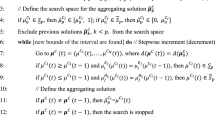Abstract
A multi-adjoint fuzzy relation equation is defined from a sup-composition operator, which combines different conjunctions. The choice of such compositions has a direct impact on the resolution of the equation. This paper presents a first approach to the consequences of modifying the sup-composition associated with a multi-adjoint fuzzy relation equation in its solution set. Firstly, we show that greater conjunctions lead to lower greatest solutions. Then, two counterexamples are presented to highlight that, in general, an existing ordering in the conjunctions does not lead to comparable minimal solutions. Nevertheless, if the minimal solutions are comparable, we show that greater conjunctions lead to lower minimal solutions.
Supported by the 2014–2020 ERDF Operational Programme in collaboration with the State Research Agency (AEI) in project PID2019-108991GB-I00, and with the Department of Economy, Knowledge, Business and University of the Regional Government of Andalusia in project FEDER-UCA18-108612, and by the European Cooperation in Science & Technology (COST) Action CA17124.
Access this chapter
Tax calculation will be finalised at checkout
Purchases are for personal use only
Similar content being viewed by others
Notes
- 1.
\([0,1]_m\) denotes a regular partitions of [0, 1] into m pieces, for example, \([0,1]_4=\{0,0.25,0.5,0,75,1\}\) divides the unit interval into four pieces.
References
Alcalde, C., Burusco, A., Díaz-Moreno, J.C., Medina, J.: Fuzzy concept lattices and fuzzy relation equations in the retrieval processing of images and signals. Int. J. Uncertain. Fuzz. Knowl.-Based Syst. 25(Supplement-1), 99–120 (2017). https://doi.org/10.1142/s0218488517400050
Aliannezhadi, S., Abbasi Molai, A.: A new algorithm for geometric optimization with a single-term exponent constrained by bipolar fuzzy relation equations. Iran. J. Fuzzy Syst. 18(1), 137–150 (2021). https://doi.org/10.22111/ijfs.2021.5879
Cornejo, M.E., Díaz-Moreno, J.C., Medina, J.: Multi-adjoint relation equations: a decision support system for fuzzy logic. Int. J. Intell. Syst. 32(8), 778–800 (2017). https://doi.org/10.1002/int.21889
Cornejo, M.E., Lobo, D., Medina, J.: On the solvability of bipolar max-product fuzzy relation equations with the standard negation. Fuzzy Sets Syst. 410, 1–18 (2021). https://doi.org/10.1016/j.fss.2020.02.010
Cornejo, M.E., Lobo, D., Medina, J., De Baets, B.: Bipolar equations on complete distributive symmetric residuated lattices: the case of a join-irreducible right-hand side. Fuzzy Sets Syst. (2022). https://doi.org/10.1016/j.fss.2022.02.003
Cornejo, M.E., Medina, J., Ramírez-Poussa, E.: Algebraic structure and characterization of adjoint triples. Fuzzy Sets Syst. (2021). https://doi.org/10.1016/j.fss.2021.02.002
Cornejo, M.E., Medina, J., Ramírez-Poussa, E.: A comparative study of adjoint triples. Fuzzy Sets Syst. 211, 1–14 (2013). https://doi.org/10.1016/j.fss.2012.05.004
De Baets, B.: Analytical solution methods for fuzzy relation equations. In: Dubois, D., Prade, H. (eds.) The Handbooks of Fuzzy Sets Series, vol. 1, pp. 291–340. Kluwer, Dordrecht (1999)
Di Nola, A., Sanchez, E., Pedrycz, W., Sessa, S.: Fuzzy Relation Equations and Their Applications to Knowledge Engineering. Kluwer Academic Publishers, Norwell (1989)
Díaz, J.C., Medina, J.: Multi-adjoint relation equations: definition, properties and solutions using concept lattices. Inf. Sci. 253, 100–109 (2013). https://doi.org/10.1016/j.ins.2013.07.024
Díaz-Moreno, J.C., Medina, J.: Using concept lattice theory to obtain the set of solutions of multi-adjoint relation equations. Inf. Sci. 266, 218–225 (2014). https://doi.org/10.1016/j.ins.2014.01.006
Medina, J., Ojeda-Aciego, M., Ruiz-Calviño, J.: Formal concept analysis via multi-adjoint concept lattices. Fuzzy Sets Syst. 160(2), 130–144 (2009). https://doi.org/10.1016/j.fss.2008.05.004
Medina, J.: Multi-adjoint property-oriented and object-oriented concept lattices. Inf. Sci. 190, 95–106 (2012). https://doi.org/10.1016/j.ins.2011.11.016
Medina, J., Ojeda-Aciego, M., Valverde, A., Vojtáš, P.: Towards biresiduated multi-adjoint logic programming. In: Conejo, R., Urretavizcaya, M., Pérez-de-la-Cruz, J.-L. (eds.) CAEPIA/TTIA -2003. LNCS (LNAI), vol. 3040, pp. 608–617. Springer, Heidelberg (2004). https://doi.org/10.1007/978-3-540-25945-9_60
Pedrycz, W.: Fuzzy relational equations with generalized connectives and their applications. Fuzzy Sets Syst. 10(1–3), 185–201 (1983). https://doi.org/10.1016/S0165-0114(83)80114-6
Sanchez, E.: Resolution of composite fuzzy relation equations. Inf. Control 30(1), 38–48 (1976). https://doi.org/10.1016/S0019-9958(76)90446-0
Turunen, E.: On generalized fuzzy relation equations: necessary and sufficient conditions for the existence of solutions. Acta Universitatis Carolinae. Mathematica et Physica 28(1), 33–37 (1987). http://eudml.org/doc/246361
Yager, R.R.: An approach to inference in approximate reasoning. Int. J. Man Mach. Stud. 13(3), 323–338 (1980). https://doi.org/10.1016/S0020-7373(80)80046-0
Author information
Authors and Affiliations
Corresponding author
Editor information
Editors and Affiliations
Rights and permissions
Copyright information
© 2022 Springer Nature Switzerland AG
About this paper
Cite this paper
Lobo, D., López-Marchante, V., Medina, J. (2022). On the Effects of Conjunctions in the Solution Set of Multi-adjoint Fuzzy Relation Equations. In: Ciucci, D., et al. Information Processing and Management of Uncertainty in Knowledge-Based Systems. IPMU 2022. Communications in Computer and Information Science, vol 1601. Springer, Cham. https://doi.org/10.1007/978-3-031-08971-8_12
Download citation
DOI: https://doi.org/10.1007/978-3-031-08971-8_12
Published:
Publisher Name: Springer, Cham
Print ISBN: 978-3-031-08970-1
Online ISBN: 978-3-031-08971-8
eBook Packages: Computer ScienceComputer Science (R0)




